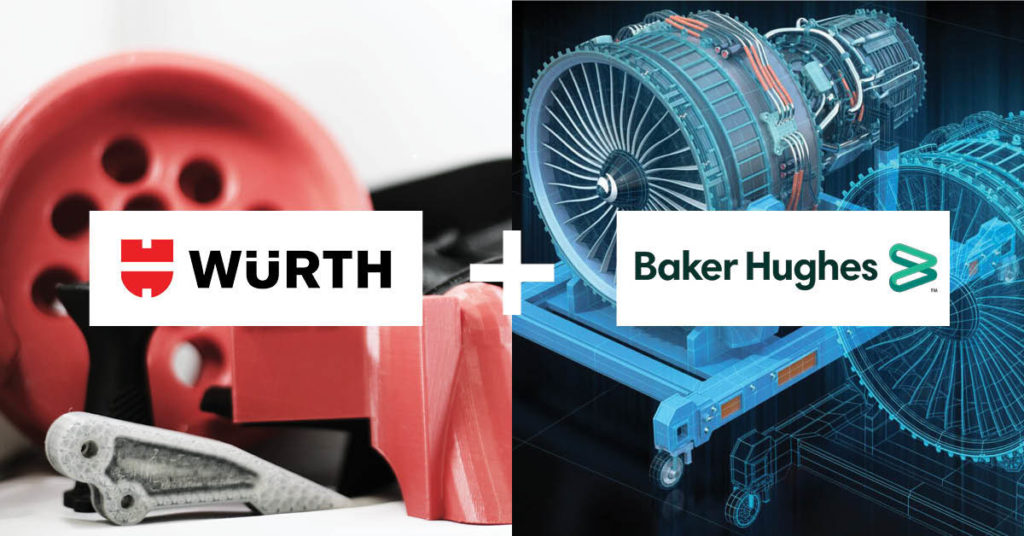Würth Industry North America (WINA) and Baker Hughes (NYSE: BKR) have announced that they will be partnering to provide design and additive manufacturing (AM) services across a number of industries, including oil and gas, renewables, power generation, maritime, automotive, and aerospace. The program is a part of WINA’s larger digital inventory and 3D printing strategy.
The $1 billion North American subsidiary of the German Würth Group, WINA already announced its partnership with Markforged earlier this year. The company is using Markforged metal 3D printing and continuous fiber reinforcement 3D printing technologies to provide 3D printing services as a part of its efforts to establish digital inventory for its customers. The Würth Group itself is one of Germany’s largest private companies, with annual revenues of €14.27 billion in 2019, over 78,000 employees and over 400 companies in 86 countries. It is also the world’s largest fastener distribution company.
With a 2018 revenue of $22 billion, Baker Hughes is one of the largest oil field services companies in the world, providing oil field services and products, as well as turbomachinery and digital solutions. For its part, Baker Hughes has had a complicated relationship with a giant in the additive space: GE. In 2017, the company was merged with GE Oil & Gas before divesting itself once more in September 2019. GE now owns less than 37 percent of the firm.
However, outside of its stint as a GE company, the company has significant 3D printing experience, with over 450 3D printed parts in production and more than 25,000 components 3D printed so far. Among the items it has printed are drill bits made via a combination of directed energy deposition (DED) and casting, with DED used to add material to a casted core. Other parts include nozzles and inserts for aeroderivative turbines made using metal powder bed fusion (PBF). The company relies on such equipment as DMG Mori’s Lasertec 65 DED system, EOS, SLM Solutions and Renishaw PBF machines. Baker Hughes has also explored 3D printing copper heat exchangers and subassemblies produced with PBF, as well as multi-material subassemblies made with DED.
In other words, this partnership will see the combining of two very large forces. Baker Hughes will now have access to Würth’s base of over 80,000 customers. Among the first clients that the duo will be working with is none other than NASA. Baker Hughes is using a combination of directed energy deposition and machining to adapt and print a NASA design for use in wind tunnel testing.
“The collaboration with Baker Hughes broadens our offering in 3D printing and beyond,” said Dan Hill, chief executive officer for WINA. “Our existing inventory programs gain a level of automation with no infrastructure change, and we can take our customers’ ideas from prototype to small batch production to mass production at accelerated rates.”
Würth will be offering the energy giant’s additive manufacturing services so that they may produce parts on demand. Additionally, Baker Hughes’ digital inventory will be deployed to enable customers to shift to cloud storage of digital designs, rather than physical storage in warehouses. This is powered by machine learning algorithms, as well as past maintenance records, production forecasts, and other documentation which make it possible for Baker Hughes to choose parts that best suited for 3D printing. In turn, they can digitize the items and produce them on-demand.
“Now more than ever, industrial companies are looking for innovative manufacturing solutions to reduce lead times and eliminate physical inventories, while reducing the carbon footprint of operations, and we believe additive manufacturing plays an important role,” said Scott Parent, chief technology officer for Digital Solutions at Baker Hughes. “By combining our advanced design and additive manufacturing capabilities with Würth’s global customer base, we can expand the scope and scale of our services outside of oil and gas. We are excited to can take advantage of this opportunity and transform the future of work.”
This development signals the maturing of additive manufacturing into a truly industrial technology. Where once the space was dominated by stalwarts like Stratasys and 3D Systems, the field is increasingly dominated by GE, HP and Siemens. Now that Baker Hughes and Würth are in the mix, we will see the 3D printing industry become a standard tool in the larger world of manufacturing.
